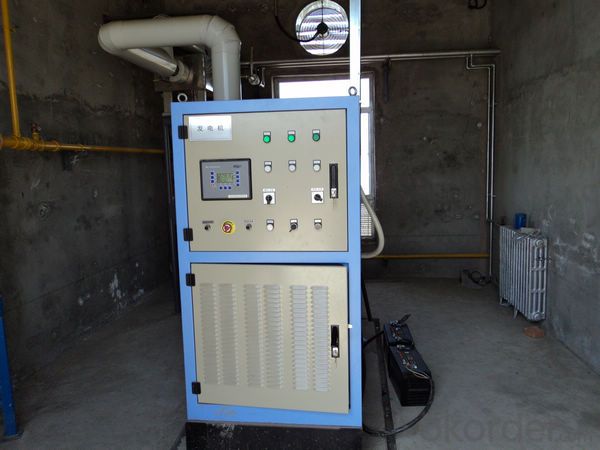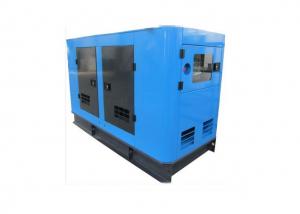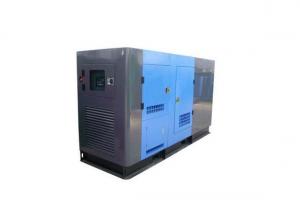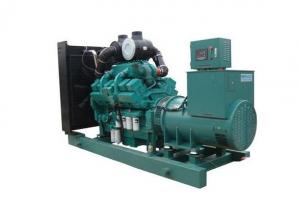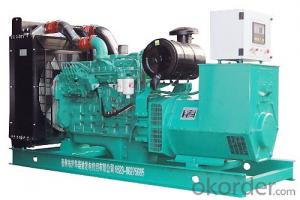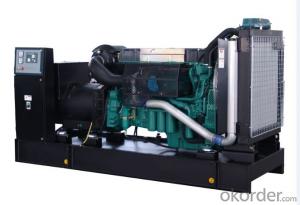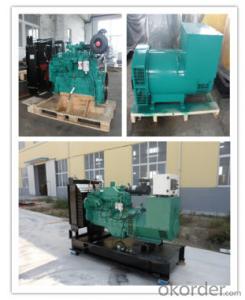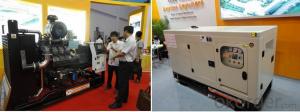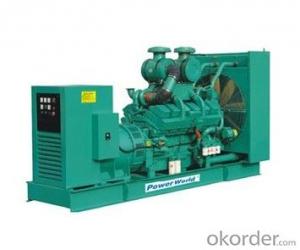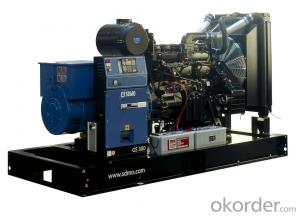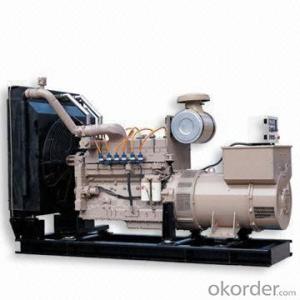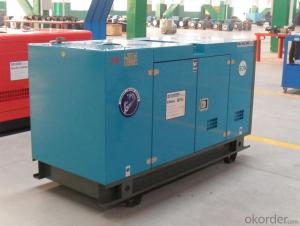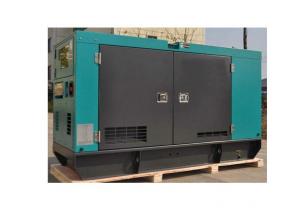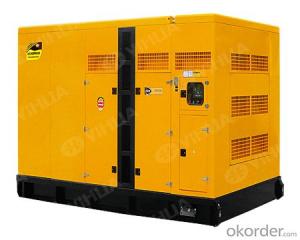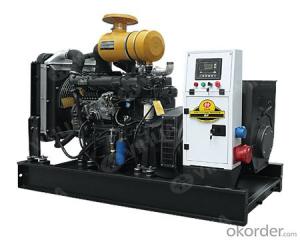Factory price china yuchai diesel generator sets 100kw
- Loading Port:
- Shanghai
- Payment Terms:
- TT OR LC
- Min Order Qty:
- 1 unit
- Supply Capability:
- 300 unit/month
OKorder Service Pledge
Quality Product, Order Online Tracking, Timely Delivery
OKorder Financial Service
Credit Rating, Credit Services, Credit Purchasing
You Might Also Like
Diesel generator Powered by Yuchai Engine,which yuchai is a large state-owned enterprise and a Nasdaq listed company in USA (NYSE:CYD). Its main business covers diesel engine, contruction machinery, vehicle parts. The engines produced by Yuchai include series YC6G, YC4G, YC4E to which American technology applied, series YC6A, YC6B, YC6J, YC4B, YC4D, YC4F, YC4W to which German technology applied, and YC6M series in which world top technology integrated, totally 12 series.
| YUCHAI Series | Power(KW) | Power(KVA) | Jichai Engine Model | Cylinder NO. | Fuel consumption g/kw.h | DimensionL*W*H | Weight KG |
| FKS-Y18 | 18 | 22.5 | YC2108D | 2 | ≤225 | 1700*700*1000 | 650 |
| FKS-Y24 | 24 | 30 | YC2115D | 2 | ≤220 | 1700*700*1000 | 650 |
| FKS-Y30 | 30 | 37.5 | YC2115ZD | 4 | ≤205 | 1700*750*1000 | 900 |
| FKS-Y40 | 40 | 50 | YC4D60-D21 | 4 | ≤205 | 1800*750*1200 | 920 |
| FKS-Y50 | 50 | 62.5 | YC4D85Z-D20 | 4 | ≤200 | 1800*750*1200 | 950 |
| THY-64 | 64 | 80 | YC6B100-D20 | 6 | ≤205 | 2250*800*1300 | 1200 |
| FKS-Y75 | 75 | 93.75 | YC6B135Z-D20 | 6 | ≤202 | 2250*800*1300 | 1250 |
| FKS-Y90 | 90 | 112.5 | YC6B135Z-D20 | 6 | ≤202 | 2250*800*1300 | 1300 |
| FKS-Y100 | 100 | 125 | YC6B155L-D21 | 6 | ≤200 | 2300*800*1300 | 1500 |
| FKS-Y120 | 120 | 150 | YC6B180L-D20 | 6 | ≤192 | 2300*830*1300 | 1600 |
| FKS-Y140 | 140 | 175 | YC6A210L-D20 | 6 | ≤192 | 2300*830*1300 | 1700 |
| FKS-Y150 | 150 | 187.5 | YC6A230L-D20 | 6 | ≤192 | 2400*970*1500 | 2100 |
| FKS-Y160 | 160 | 200 | YC6G245L-D20 | 6 | ≤195 | 2500*970*1500 | 2300 |
| FKS-Y180 | 180 | 225 | YC6L285L-D30 | 6 | ≤197 | 2600*970*1550 | 2500 |
| FKS-Y200 | 200 | 250 | YC6M350L-D20 | 6 | ≤197 | 3100*1050*1750 | 2750 |
| FKS-Y220 | 220 | 275 | YC6M350L-D20 | 6 | ≤197 | 3100*1100*1750 | 2800 |
| FKS-Y280 | 280 | 350 | YC6MK410L-D20 | 6 | ≤195 | 3200*1150*1750 | 3000 |
| FKS-Y300 | 300 | 375 | YC6MK470L-D20 | 6 | ≤195 | 3200*1200*1750 | 3100 |
| FKS-Y320 | 320 | 400 | YC6K500L-D30 | 6 | ≤195 | 3250*1200*1750 | 3200 |
| FKS-Y350 | 350 | 437.5 | YC6K550L-D30 | 6 | ≤195 | 3250*1250*1750 | 3250 |
| FKS-Y350 | 350 | 437.5 | YC6T550L-D21 | 6 | ≤195 | 3300*1250*1850 | 3500 |
| FKS-Y400 | 400 | 500 | YC6T600L-D22 | 6 | ≤195 | 3400*1500*1970 | 3900 |
| FKS-Y440 | 440 | 550 | YC6T660L-D20 | 6 | ≤195 | 3500*1500*1970 | 4000 |
| FKS-Y500 | 500 | 625 | YC6T755L-D20 | 6 | ≤195 | 4000*1500*2000 | 5000 |
| FKS-Y650 | 650 | 812.5 | YC6C1020L-D20 | 6 | ≤195 | 4500*1800*2500 | 7500 |
- Q: Hi GuysOkay i have been given the task of fitting a 240v generator to an RV in to one of it's closet spaces.It needs to power one 240v socket, charge the RV battery (standard battery on trickle charge) and power the shower which doesn't have a boiler as such it heats the water on a 'as and when' basis. Low wattage lighting also two 40W lightsThere is plenty of space. so I thought how about try and fit a generator than runs on renewable energy.I just need to know what direction I should be looking in. HydrogenSolar (Doubt it)Bio-FuelAnything else?Also, is it best to convert an existing design of generator, buy a new one or build one from scratch to fit?Any help would be truly awesomePeace
- Electric heating of your hot water is very inefficient since you have so much heat rejected in the exhaust for every KWHr you make. Your best bet would be to use the exhaust heat and/or jacket cooling water from a biofueled generator to heat the hot water tank. You get very high efficiencies from that combination. I have seen such devices talked about (see the link below) for years, but have recently seen one that is actively under development. It may be a bit oversized for your RV, however, since it is for a house. You may be able to just add a heat exchanger on the exhaust and use a small, thermostatically controlled pump to circulate the hot water from the tank through the tubes. Biofuels are not as available as gasoline, but if you research where you are going, you may find they are more prevalent than you think. Also, the generator will be able to run on fossil fuels as well, giving you a back up in case you can't find biofuel. Hydrogen is interesting, but I can't think a commercially available generator that runs on it. And you would still have the efficiency issue unless you recovered the exhaust heat like I have said for the biofuel. I can't think that solar would work well, you have such a limited amount of collection surface on the roof, and lugging around batteries and/or hot water is also inefficient. I have been on trips where it was cold and cloudy for a week, solar would not do well under those circumstances.
- Q: how does a generator work powerlessly. i mean like if there is a black out people cna generate energy from like a generator. well then how come a generator work without the help of anything? (NOT TALKInG About the hydropower generator, the one that spins.
- As pointed out generators convert mechanical energy into electricity. The mechanical energy is provided by an engine that uses some type of fuel like diesel or natural gas. All generators spin to produce power. well then how come a generator work without the help of anything? Backup generators do seem to magically produce electricity during a power failure Backup generators are fitted with automatic controls that handle the starting and placing of the generator onto the buildings power bus. The automatic controls are powered from the AC mains to keep a set of batteries charged. THe batteries are used at the beginning of a blackout to power the automation and start the generator. (Once the generator is running these batteries may then be recharged from the power produced by the generator or when the AC mains is re-established.) Electronic controls sense the loss of AC power and trigger a starting sequence. The generators starter is engaged to crank over the diesel or Gas engine. The controls monitor this process to ensure the engine actually starts and that an excessive amount of cranking doesn't occur. Once the engine is running and brought up to proper speed additional automatic controls disconnect the now powerless AC mains from the buildings buss and connect the Generator power to the buildings electrical panel. Based upon the size of the generator some or all of the buildings power may be supplied by the backup generator. Without the automation the process is still the same except a persone would have to perform the process of starting the gen and placing it on line. Its not difficult to do but does require some trainng. Automation performs this startup process quicker that what a humam would be likely to do.
- Q: I am buying a portable generator in order to power up to six, 500 watt halogen work lights to light up my horse arena at night. what are some things I should consider in terms of features that are needed in this application. Also, I don't want alot of bells and whistles, I need to keep as low cost as possible but still safe and quiet.
- To the past comment regarding fuel consumption - You sated: For some reason, a big generator- say 6000 watts will go through twice as much gas as two 3000 watt generators! No idea why. Look it up if ya want. Totally true. Anyways, that ratio is far from accurate. Don t be misconstrued by not taking into account the fact that the listed specs for any unit describes fuel consumption based on load. All the listed specs show consumption-over-time, indicating that that consumption is during operation of the unit while at only 1/2 of the maximum rated load capacity. For your perusal, some generator specs taken from authorized Honda dealer web sites. Honda ~3500 (max watt) series Tank Size:6.2 Gallons Run Time (50% Load):16 Hours And the Honda ~6500 (max watt) series 6.2 Gallons Run Time (50% Load):10.4 Hours Anyways, if one were to crank up the Honda3500 from its 1/2 load of say 1750watts, to say about 3200watts, I would gamble the fuel consumption rate would spike significantly, and to the point where heat and exhaust would factor in largely; the 1/2 load operation for the 6500 series would yield 3250watts, incidentally. Even if there were so be some kind of (likely negligible if any) savings by having and utilizing 2 of the 3500 units at the same time, would it make up for the additional money spent on the cost of ownership of the 2 units, versus the single expense of the more powerful unit? (one of the 3500w units $1,600 while the 6500w costs about $2700+/-) Also, would someone want to occupy space with 2 units at once, either while in use or in storage? What about the chance of more things going wrong while running 2 units, let alone the increase in noise (et al) pollution. I would fathom the 6500w engine, and all moving components, would be much less taxed over time with respect to the similar output of the 2-unit scenariowhich sounds chaotic and in illogical, and was not even thought out.
- Q: HI, I'm a college student Marine EngineeringI don't know the procedures of*pre-start up*start-up*stoppingof an emergency AC Generatorplz. help :)I'm going to monitor during operation that's why I want to know all of thatplease response as soon as possible.
- Before check all fluid levels and turn off all breakers before starting or stopping!
- Q: Does any one know the best way to go about have an entire house run off of a generator? Mostly likely over periods of no great than two weeks. But it needs to supply a Washer/Dryer, Central A/C, Water Heater, and all of the basics of a smaller house. I did the math and the math says the max I will need is apprx 13,500W. I've done a lot of research on portable, residential, and even green energy, but I am having trouble finding the best way to go about powering a house continually. I need something relatively quiet, or something I can run a ways from the house.And lastly one more curve ball, this is for west TX, so there's not too much rain, especially these days. But it is a desert atmosphere, so I need a way to keep it out of the elements. Any suggestions? Well ventilated shed maybe? Thanks!
- This would need to be a big and expensive generator, probably water-cooled - check out prices on OKorder - if you are only there 2 weeks at a time, that is a lot of money to spend, and a big risk to leave it where it could be stolen when you are away. May I respectfully suggest that you consider non-electric alternatives? It seems rather out of place, and certainly not very green to have a petrol or diesel generator chugging away for 2 solid weeks close to what I guess is a holiday home somewhere remote in the countryside. There are fridges and freezers available which run off LPG (propane or butane) and even kerosene (which might be easier for you to transport to your holiday home) The same goes for a water heater and cooker A washer/drier seems unnecessary (and also not at all green) if you live in a desert atmosphere - take a look on OKorder with the search words as follows: caravan washing machine These small machines use very little water and energy, which I suggest will be important factors for you. Finally aircon (the trade I presently work in) - may I suggest that you look for simple, low energy units that use water evaporation for cooling (will also humidify the dry desert air) - if you follow all the above guidelines, you should be able to get by with a 3 or 5KW portable generator that you can take home for safe-keeping. Sorry to rain on your parade, but I think the idea of an all electric holiday home in the wilderness is in need of a serious re-think for many reasons. Good luck!
- Q: If you were talking on the phone to someone and dropped the phone into a bathtub filled with water would they get electrocuted? Does it matter if it's wireless or not?
- No and yes. No they would not get electrocuted because they DROPPED the phone. They would also not be electrocuted because phones operate on 60 volts. Enough to feel, but newhere near enough to hurt you, bathtub or no. Wireless makes a difference because it runs on batteries. The batteries would short out, the phone would be destroyed. But in no way do the batteries contain enough energy to kill you.
- Q: i need a generator that can be continually run for years it needs to be able to easlly provide enough power for five one person cabinsi am going to use this to power a camp so it needs to withstand the outdoor elements i am looking for a brand name and an approximate costthank you to all who answer
- Contact several local electrical contractors in your area to get some design build estimates. The size is a small consideration rather the durable type of generator you need that can run as a quiet unit for many years is a problem. The best solution is probably 2 or 3 medium size generators that can be run in a parallel configuration. 5 units to power might be as little as 100 amps each so 500 amps at 240 volts is about a 120KW so 3 units of 40 KW each might be a consideration. Using multiple units will allow maintenance on one unit and not lose power. For prices the electrical contractor in your area will know more about what the labor rates are for this type of project. I will give AWAG that $10,000 per KW is not too far off.
- Q: If oil prices went super crazy.
- If oil prices continue to go up with no sign of relief (meaning years into the future) then, as others have already said, I think many of the large railroads which could afford it would begin contemplating energizing at least their most heavily used main lines. Still, even with today's AC technology being very efficient and allowing one to string wires over vast distances without a significant power loss it is still awfully expensive. Trains Magazine covered a piece a few years ago on the likelihood of railroads (Class Is) ever electrifying significant portions of their systems and came to the conclusion that unless absolutely justifiable they would seek other alternatives due to high costs of construction. While steam might be such an alternative they would try it's still pretty maintenance intensive and would require frequent fuel stops resulting in increased transit times (even with the newer technologies the motive power would employ). Just purely an educated guess but I think that the industry might go for something like the locomotives developed by RailPower Technologies, which use batteries and diesel generators as prime movers. If a company like RailPower could develop a much more powerful model than what they currently offer (which is only around 2,000 hp), similar to the SD70ACes and ES44ACs of today, then you would have an extremely fuel efficient locomotive that is powerful enough to move the heaviest freight yet also very environmentally friendly.
- Q: I understand it as far as the diesel engine driving the generator- or is it an alternator?- to power the motors which turn the wheels. But does each wheel have its own motor, or is it one motor per axle?
- Diesel-electric locomotives most commonly use one traction motor per axle, with the motor shaft parallel to and beside the wheel axle and with a simple pair of gears connecting the two. Early diesel-electric locomotives used a DC generator that directly fed DC traction motors, with the generator often doubling as a starter motor. By the 1970s, locomotives commonly used alternators (which were easier to maintain) that generated AC current, which was rectified back to DC to power the same DC traction motors as before. The EMD GP38 was notably produced with both a generator and an alternator, with the alternator-powered version called the GP38AC. AC traction motors became commonplace in the early to mid 1990s - but they do not use the electricity produced by the alternator directly as it is not of the correct frequency. The AC power from the alternator is first rectified to DC, then (using inverters) back to AC current of the correct frequency for the traction motors. GE locomotives use one inverter per traction motor, while all but the most recent EMD locomotives used one inverter per truck. The traction motors are readily visible on six-axle units such as recent EMD SD series locomotives or GE Dash-9 and AC units. These locomotives all have traction motors that face inwards, so that they all face the same direction on each truck. On the innermost axle they extend considerably beyond rim of the wheels toward the fuel tank, visible in this photo I took of an EMD SD40-2: trainiax /photos/2013/2013-05- To account for the different current and resistance characteristics of the electric motors at low and high speed, locomotives have one or several transitions between wiring the motors in series or in parallel, or in a combination of both.
Send your message to us
Factory price china yuchai diesel generator sets 100kw
- Loading Port:
- Shanghai
- Payment Terms:
- TT OR LC
- Min Order Qty:
- 1 unit
- Supply Capability:
- 300 unit/month
OKorder Service Pledge
Quality Product, Order Online Tracking, Timely Delivery
OKorder Financial Service
Credit Rating, Credit Services, Credit Purchasing
Similar products
Hot products
Hot Searches

